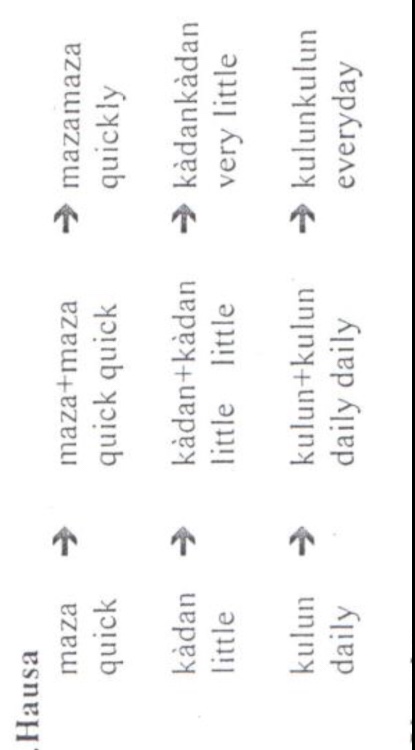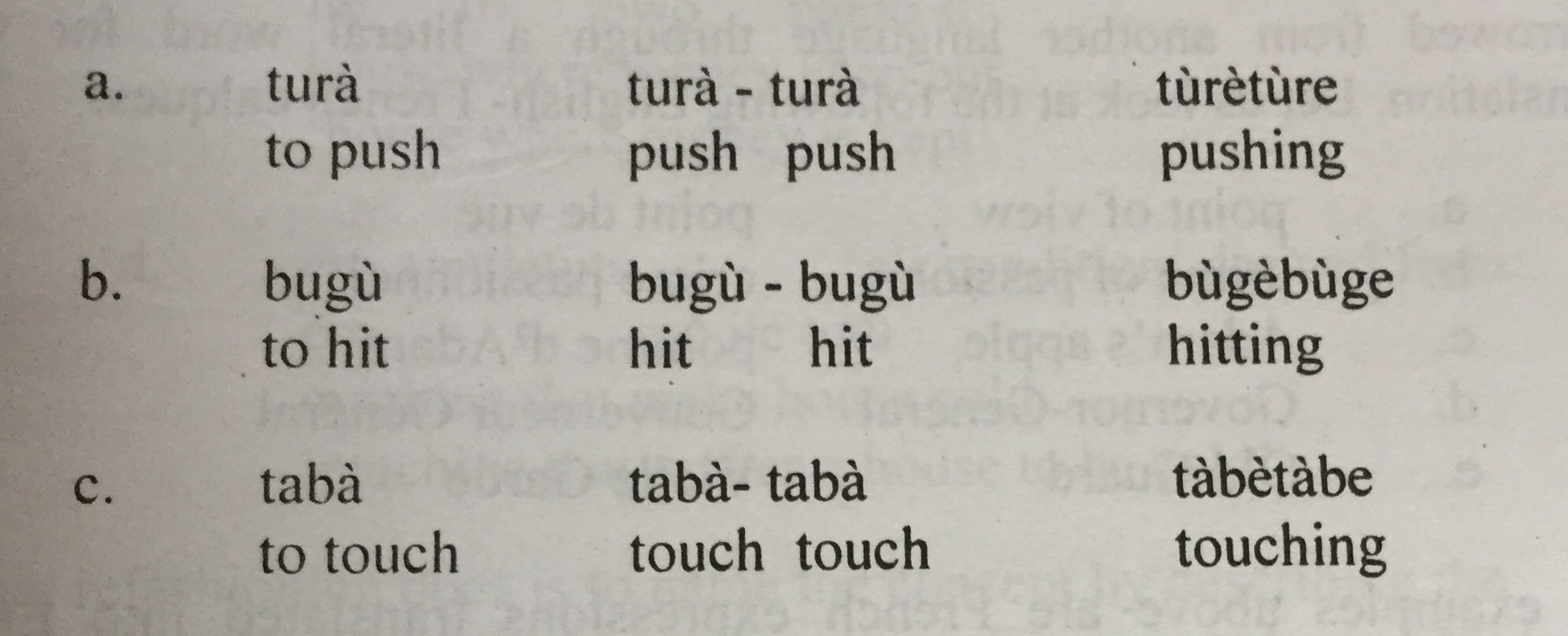Morphology Series XVII
Reduplication is a common morphological process that most languages use in forming words. It occurs when a part or a whole word or phrase is repeated to form new words.
Reduplication involves the copying of the base or part of the base and attaching it to the base either before or after. There are basically two types of reduplication, partial reduplication and total reduplication.
Partial Reduplication
Partial reduplication involves the copying of a part of the base. Any part of the base could be copied and attached either before or after the base.
In Yoruba for example, the initial consonants of verbs which are usually monosyllabic are copied and the high front vowel [i] is inserted since the language does not allow consonant clusters.
1.
Base Reduplicated Form
a. tà ‘to sell’ t-í-tà títà ‘selling’ b. lò ‘to use’ l- í-lò lílò ‘using’ c. rà ‘to buy’ r –í- rà rírà ‘buying’
d. gbà ‘to take’ gb-í-gbá gbígbà ‘taking’
In the derivation of nominalized verbs in Hausa, the CV of the first syllable is duplicated and prefixed to the base to derive action nouns from verbs.
2.
Base Reduplicated Form
a. bùgu ‘to hit’ bùb- bùgu bùbbùgu ‘hitting’
b. zùngùre ‘to poke’ zùngùre-re zùngùrere ‘poking’
Let us also consider the following examples from Ponapean taken from Rehg (1981, p. 78).
3.
Base Reduplicated Form
a. duhp ‘dive’ du-duhp ‘to be diving’
b. mihk ‘suck’ mi-mihk ‘to be sucking’
c. wehk ‘confess’ we-wehk ‘to be confessing’
From the data, we see that Ponapean reduplicates a CV sequence and
prefix it to the stem.
2. Total Reduplication
Total reduplication involves the copying of the entire base to derive a new word.
Reduplication is a very common morphological process in languages. Consider the following Yoruba examples.
4.
a. pana paná+paná panápaná
kill fire kill fire kill fire ‘fire fighter’
b. gbọ́mọ gbọ́mọ+ gbọ́mọ gbọ́mọgbọ́mọ
carry child carry child carry child ‘kidnapper’
c. kólé kólé+kólé kólékólé
pack house pack house pack house ‘thief’
d. gbálẹ̀ gbálẹ̀+gbálẹ̀ gbálẹ̀gbálẹ̀
sweep ground sweep ground sweep ground ‘cleaner’
e. wolé wolé+wolé woléwolé
look house look house look house ‘sanitary inspector’
The reduplicated words in Yoruba are derived from verb phrases (not compounds) with nouns incorporated in them.
These verb phrases are then reduplicated to derive nouns in the language. Hausa also attests reduplication.
Consider the following Hausa examples which involve the formation of adverbs from adjectives and the nominalization of verbs.
5.

The reduplicated forms in these examples do not change any part of the segment. However, there are some total reduplication in Hausa where there is a bit of modification to the derived form after the reduplication. Consider the following data in (6) where the final vowel of the base is modified in the derivation of action nouns in the language.
6.

Igbo also attests total reduplication as exemplified in the derivation of
adverbs from adjectives.
7.
a. mbia ‘visit’ mbia-mbia ‘visitation’
b. ọ́sọ́ ‘quickly ọ́sọ́-ọsọ́ ‘quickly’
c. ńwáyọ̀ọ̀ ‘slow’ ńwáyọ̀ọ̀-ńwáyọ̀ọ̀ ‘slowly’
Reduplication with inter-fixation is attested in Owé, a dialect of Yoruba as shown in (8). This is a process whereby a morpheme that serves the function of joining two reduplicated segments is inter-fixed between the two totally reduplicated morphemes. For example:
8.

The reduplicated and the derived forms are also nouns.
Exercises
1. Identify the morphological constituents and describe the morphological process in operation in the following Malagasy data.
be ‘big, numerous’
be-be ‘fairly big, numerous’
fotsy ‘white’
fotsi-fotsy ‘whitish’
maimbo ‘stinky’
maimbo-maimbo ‘somewhat stinky’
hafa ‘different’
hafa-hafa ‘somewhat different’
(Keenan and Polinsky 1998, p. 571)
2. Consider the following data from Tzeltal spoken in Mexico. Determine the meaning of the suffixes.
tatab ‘fathers’ tat ‘father’
nič’nab ‘sons’ nič’an ‘son’
k’abal ‘custody’ k’ab ‘hand’
3. Explain the processes of word formation.
NB
a. Excerpts are taken from Arokoyo (2006, 2017 and 2018).
b. For previous lectures on morphological processes, see Conversion, Compounding, Borrowing and Acronyms
References
Arokoyo, Bolanle Elizabeth. (2018). Owé Linguistics: an Introduction. Aba: NINLAN. https://bit.ly/36uYAFw
Arokoyo, Bolanle Elizabeth. (2017). Unlocking Morphology. Ilorin: Chridamel Books.
Arokoyo, B.E. (2006) A Comparative Study of Reduplication in Hausa and Standard Yoruba. In ALORE: Ilorin Journal of the Humanities, 16, 133- 151. https://bit.ly/314O2wg
Keenan, Edward L. and Polinsky, Maria. (1998). Malagasy. In Spencer and Zwicky (eds). The handbook of morphology. Oxford: Blackwell. 563-623.
Rehg, Kenneth L. (1981). Ponapean reference grammar. Honolulu: University of Hawaii Press.

This series provides a scintillating guide to reduplication and it has helped in the preparation of a journal article. Thank you.
Great! Thanks for the positive feedback.
First, I would commend you on your effort to simplify reduplication as siting the different languages in Nigeria, but it would have been thorough if you had cited the right examples. I thought you would have done better by applying the phonotactic rules to truly confirm your claims. second, the interpretations of some examples like in the Igbo language mbia ‘visit’ mbia-mbia ‘visitation’
b. ọ́sọ́ ‘quickly ọ́sọ́-ọsọ́ ‘quickly’
c. ńwáyọ̀ọ̀ ‘slow’ ńwáyọ̀ọ̀-ńwáyọ̀ọ̀ ‘slowly’. The interpretations given to these verbs are not correct. “Mbia” – means “Come” while “mbia Osiso” “come quickly”. The same goes for the others.
In the same likeness, the interpretations given to the other two languages are not in the light of their real interpretations. For instance “Kole” “Kole-kole” should have been interpreted as “Burglary” and not “thief” also there is a deletion of the vowel “i” from the initial morphological structure of “ko ile”, in other words, we have the deletion of the initial phoneme in the second syllable and the stretching of “o” in the first syllable to the other.